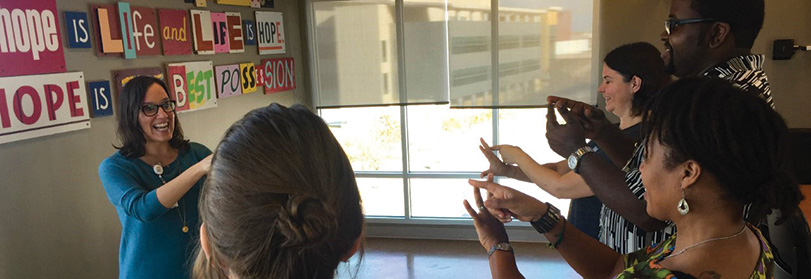In the Classroom

Mindfulness Strategies for the Classroom
By: James Butler, Austin ISD SEL Mindfulness Specialist, and Emily Hoaldridge-Dopkins, Austin ISD SEL Specialist
It’s no secret that teachers have a lot to accomplish every day. Integrating social and emotional learning (SEL) into class routines provides students with valuable life skills and can help make learning more efficient. SEL helps improve class relationships, which fosters learning across content areas. Mindfulness is a tool that supports SEL in and out of the classroom. A practical definition of mindfulness is “right here, right now: paying attention on purpose, responding, and being kind to yourself.” In Austin ISD, one of the nation’s leaders in SEL, mindfulness is being implemented in one way or another on nearly 100 campuses, and the number keeps growing.
Why:A common misconception is that mindfulness is mostly a self-regulation tool. However, when practiced consistently, mindfulness increases proficiency in the five core competencies of SEL (created by CASEL, an organization that supports SEL in schools).
- Self-awareness: Enhances your ability to focus attention and improves self-compassion
- Self-management: Increases emotion regulation skills
- Social awareness: Increases empathy by helping the individual regulate emotions rather than getting overwhelmed during difficult situations
- Relationship skills: Increases compassion and deep listening
- Responsible decision making: Increases cognitive flexibility and creativity
There are many ways to practice being present in the classroom. Here are a few quick and easy mindfulness activities:
Mindful Stretching“Dolphin pose”—Sit or stand. Stretch your arms behind your back. Grasp your hands, gently lift your arms, and look up. Take five deep breaths. Get creative and come up with your own “poses.”
Mindful Breathing“Finger tracing”—Hold one hand with outstretched fingers. Touch the bottom of your outstretched thumb with a finger from your other hand. Breathe in and slowly move your finger up your thumb. Breathe out and slowly move your finger down your thumb. Continue as you trace your outstretched hand from your thumb to your pinky. Repeat with other hand.
Mindful Listening“Listen to the bell”—Play the sound of a bell or chime and have your students focus on the sound while taking slow, steady, controlled breaths. The volume will decrease, and when your students can no longer hear the sound, have them raise their hand. You can also do this with eyes closed and open them when the sound fades away.
Mindful Seeing“Find something new”—Set a timer for one minute or play a chime. While taking slow, steady, controlled breaths, students notice their surroundings by silently looking around the room to find something they haven’t noticed before. This can be done in a variety of locations on campus.
Mindful Eating“Eat with your senses”—Using a snack, guide your students to pay close attention to their food through the five senses. Encourage them to notice texture, color, shape, ingredients, flavor, and so forth. For the first bite, intentionally go through each sense: sight, touch, smell, taste, and listening (while chewing).
When:Got a minute? Mindfulness can be practiced during different parts of your day. Here are a few suggested times to practice mindfulness with your students:
- Start of the day/class
- End of the day/class
- Transitions
- After lunch
- Brain break (when class energy level needs a change)
This content was originally published in the Spring 2017 edition of ATPE News.

